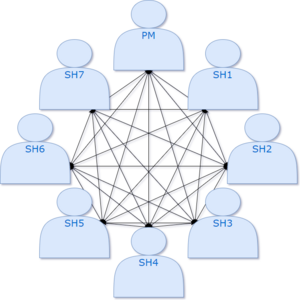Communication Management Strategy
Contents |
Abstract
Communication is a crucial aspect of any project. A study conducted by the Project Management Institute (PMI) revealed that on average, 1 out of 5 projects are unsuccessful due to ineffective communication. [1]
One reason communication is so important, yet often times overlooked, is the complexity of a project’s communications. The total number of potential communication channels is n(n – 1)/2 where n is the number of stakeholders. This means that increasing the number of stakeholders (larger projects), greatly increasing the number of channels to be considered in the Communications Management Strategy.[2]
This article explains the contents of a Communication Management Strategy in project management. The communications management strategy describes the means and the frequency of communication to parties both internal and external to the project. The strategy establishes a controlled flow of information which seeks to facilitate engagement with stakeholders.[3]
The goal of this article is to guide the reader through the process of planning communications by displaying the procedure for developing a Communications Management Strategy. The strategy is typically drafted very early, when developing the project management plan. This early planning allows for resources like time and money to be allocated to communication activities.
The communications management strategy can be a standalone document or spreadsheet, or it can be incorporated in the initial project documentation or project management tool/software. The strategy should state the communication procedure, including utilized tools, record keeping and reporting. Furthermore, it should answer the questions: When will formal communication activities take place? Who will be responsible for what aspects? Who needs what information? Where should the information be stored, and in what format? How can the information be retrieved? Other considerations such as time zones, language barriers, and cultural differences should also be considered if necessary.
The approach to developing such a plan begins with a Communication Requirements Analysis, which determines the information needs of the project stakeholders. Communications management is closely tied to stakeholder management as both subjects deal with the flow of information, and in fact, the stakeholder analysis or stakeholder register, can be considered a vital part of the Communications Management Strategy.
Big Idea
Describe the concept and purpose Project Communications Management includes all the processes that are necessary to ensure that information regarding the project flows timely and appropriately. Communication takes place externally and internally amongst the project team and other project stakeholders. Stakeholders may influence the project execution or outcome, which makes effective communication an important part of project management. Project Communications Management includes the planning, managing, and controlling of communications. This article will be looking at the planning aspect, in developing a Communication Management Strategy. PMBOK page 287 Planning project communications is based on stakeholder’s information needs and requirements as well as available organizational assets. The main benefit of the process is identifying and documenting the communication approach. The planning takes place in the early stages of project planning, incorporated in the project management plan. The following information should be considered when planning: 1. Stakeholder Register (The output of a stakeholder analysis) 2. Enterprise Environmental Factors (The organizational structure including but not limited to; location, regulation, culture, staff etc.) 3. Organizational Process Assets (Processes, procedures and corporate knowledge including but not limited to; lessons learned and historical information) The above information can be viewed as input for the planning process, whereas the Communication Management Strategy is the output. Communication Requirements Analysis PMBOK page 287 Communication Model Interactive and Push Pull
Application
How to use the concept Communication plan (communication technology assessment) Stakeholder analysis Meetings Cross functional teams (PMS PDS)
Limitations
Ongoing process.
References
- ↑ , Project Management Institute® Pulse of the ProfessionTM May 2013, The High Cost of Low Performance: The Essential Role of Communications, web:http://www.pmi.org/-/media/pmi/documents/public/pdf/learning/thought-leadership/pulse/the-essential-role-of-communications.pdf Retrieved 12 February 2018
- ↑ Project Management Institute. “A Guide to the Project Management Body of Knowledge (PMBOK® Guide)”- Fifth Edition, 2013, page 292
- ↑ ,Office of Government Commerce® , Project Management: "Managing Successful Projects with PRINCE2TM"- Fifth Edition, 2009, page 235
